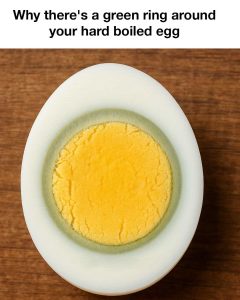Have you ever peeled a hard-boiled egg only to find a greenish-gray ring circling the yolk? If so, you’re not alone. Many people are puzzled or even concerned when they come across this strange discoloration, especially if they’ve never encountered it before. While it may look unappetizing or make you question the egg’s freshness, the truth is, this green ring is a common and harmless result of basic kitchen chemistry. In fact, it has nothing to do with spoilage or safety and everything to do with how the egg is cooked. Let’s take a closer look at what causes this curious phenomenon, whether it affects the flavor or nutrition of your eggs, and how you can avoid it if you prefer picture-perfect yolks.

The green ring is actually caused by a chemical reaction between two naturally occurring elements in eggs: sulfur and iron. When eggs are exposed to high heat for an extended period—such as during overboiling—the sulfur in the egg white reacts with the iron in the yolk. This creates a compound called ferrous sulfide, which settles at the boundary where the white meets the yolk and forms that telltale greenish layer. Even though it may not look very appealing, it’s completely safe to eat. The flavor might be slightly different in overcooked eggs, but the presence of the green ring itself does not make the egg taste bad or alter its nutritional content.
One of the biggest contributors to the green ring is overcooking. Leaving eggs in boiling water for too long or using excessively high temperatures increases the chances of the sulfur-iron reaction occurring. To avoid this, it’s crucial to understand the right cooking methods. A tried-and-true method to achieve perfectly cooked hard-boiled eggs is to place them in a pot of cold water, bring it to a gentle boil, then remove the pot from the heat and allow the eggs to sit in the hot water for about 9 to 12 minutes. This gentle cooking approach helps set the egg whites and yolks without pushing the temperature too high, reducing the risk of the green ring forming.
Another factor that plays a role is the freshness of the egg. It might surprise you to learn that fresher eggs are less likely to develop the green ring compared to older ones. This is because the pH of an egg changes as it ages. Fresh eggs tend to have a lower pH, which helps to slow down the sulfur-iron reaction. As the egg ages, its pH rises, making it more prone to this type of discoloration when boiled. So, if you’re planning to make hard-boiled eggs for a party platter or deviled eggs and you want them to look their best, you might want to opt for fresher eggs.
The exact chemical process involves hydrogen sulfide gas, which is released from the egg white when it’s heated. This gas then reacts with iron from the yolk, forming the compound ferrous sulfide. The greenish layer that appears is a deposit of this compound right around the outer part of the yolk. Depending on how much sulfur and iron are present, and how long and at what temperature the egg was cooked, the intensity of the green ring can vary from barely noticeable to dark and distinct.
Now, if you’re looking to avoid the green ring altogether, there are a few key tips to keep in mind. First, don’t overcook the eggs. Use the hot water soak method instead of keeping the pot on a rolling boil. After cooking, it’s equally important to cool the eggs quickly. An ice bath or running cold water over them will rapidly stop the cooking process and limit the sulfur-iron reaction from continuing as the eggs cool down. Quick cooling also helps make peeling the eggs easier—a bonus when you’re preparing a large batch.
There are several myths and misconceptions floating around about the green ring that are worth clearing up. One common myth is that the green ring means the egg is rotten or no longer safe to eat. This simply isn’t true. A spoiled egg will have a foul odor and possibly other signs of decay, none of which are indicated by a green ring. Another belief is that adding vinegar or salt to the boiling water can stop the green ring from forming. While these ingredients can influence the pH level slightly or help with peeling, they aren’t reliable solutions for preventing the discoloration. The real solution lies in controlling the cooking time, temperature, and cooling process.
You might also wonder if the green ring affects the egg’s nutrition. The good news is it doesn’t. The egg remains a rich source of high-quality protein, essential vitamins like B12 and D, and minerals such as selenium and phosphorus. The presence of ferrous sulfide may slightly alter the texture or flavor in cases of severe overcooking, but the egg’s nutritional value stays the same. So even if your breakfast eggs come out with a green tint around the yolk, you can eat them with confidence, knowing they’re just as nutritious.
Ultimately, whether you care about the appearance of your hard-boiled eggs is a personal choice. Some people don’t mind the green ring at all, while others prefer their yolks to look bright yellow and pristine. If you’re serving guests or using the eggs in recipes where appearance matters—like deviled eggs or salads—you might want to take the extra steps to prevent the ring. But if you’re just grabbing a quick snack or making egg salad for yourself, there’s no need to worry.
In conclusion, the green ring around a hard-boiled egg yolk is nothing more than a visual quirk caused by natural chemical reactions between sulfur and iron. It doesn’t mean the egg is bad, unsafe, or unhealthy. By understanding the science behind it and using the right cooking methods, you can prevent it from forming if you wish. But if you do come across a green ring, there’s no reason to toss the egg. It’s still a wholesome, versatile, and nutritious food that deserves a place on your plate.





